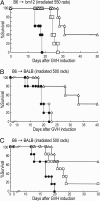Effective expansion of alloantigen-specific Foxp3+ CD25+ CD4+ regulatory T cells by dendritic cells during the mixed leukocyte reaction
- PMID: 16473944
- PMCID: PMC1413800
- DOI: 10.1073/pnas.0510606103
Effective expansion of alloantigen-specific Foxp3+ CD25+ CD4+ regulatory T cells by dendritic cells during the mixed leukocyte reaction
Abstract
Thymic-derived CD25+ CD4+ T regulatory cells (Tregs) suppress immune responses, including transplantation. Here we evaluated the ability of dendritic cells (DCs) to expand alloantigen-specific Tregs in the mixed leukocyte reaction (MLR) that develops from polyclonal populations of T cells. The allogeneic DCs, when supplemented with IL-2 in the cultures, were much more effective than bulk spleen cells in expanding the numbers of Tregs. Likewise, DCs and not spleen cells were effective in sustaining expression of the transcription factor Foxp3 in Tregs, but neither IL-2 nor CD80/86 was required for this effect in the cultures. On a per-cell basis, the DC-expanded, but not unexpanded, Tregs were more potent suppressors of a fresh MLR by CD25- CD4+ T cells. Suppression was 3- to 10-fold more active for MLRs induced by the original alloantigens than for third-party stimulators. When DC-expanded Tregs were introduced into sublethally irradiated hosts, the T cells suppressed graft-versus-host-disease induced by CD25- CD4+ T cells. Again, suppression was more active against the same mouse strain that provided the DCs to expand the Tregs. Therefore, alloantigen-selected Tregs are more effective suppressors of responses to major transplantation antigens, and these Tregs can be expanded from a polyclonal repertoire by DCs.
Conflict of interest statement
Conflict of interest statement: No conflicts declared.
Figures





Similar articles
-
Dendritic cells expand antigen-specific Foxp3+ CD25+ CD4+ regulatory T cells including suppressors of alloreactivity.Immunol Rev. 2006 Aug;212:314-29. doi: 10.1111/j.0105-2896.2006.00422.x. Immunol Rev. 2006. PMID: 16903923 Review.
-
Dendritic cells with TGF-β1 and IL-2 differentiate naive CD4+ T cells into alloantigen-specific and allograft protective Foxp3+ regulatory T cells.Transplantation. 2012 Mar 27;93(6):580-8. doi: 10.1097/TP.0b013e318244dd67. Transplantation. 2012. PMID: 22270834 Free PMC article.
-
Blockade of chronic graft-versus-host disease by alloantigen-induced CD4+CD25+Foxp3+ regulatory T cells in nonlymphopenic hosts.J Leukoc Biol. 2007 Nov;82(5):1053-61. doi: 10.1189/jlb.0407227. Epub 2007 Aug 7. J Leukoc Biol. 2007. PMID: 17684039
-
Comparative analysis of dendritic cells and anti-CD3/CD28 expanded regulatory T cells for application in transplantation.Transpl Immunol. 2009 Dec;22(1-2):82-92. doi: 10.1016/j.trim.2009.07.004. Epub 2009 Jul 25. Transpl Immunol. 2009. PMID: 19635560
-
Alloantigen specific T regulatory cells in transplant tolerance.Int Immunopharmacol. 2009 May;9(5):570-4. doi: 10.1016/j.intimp.2009.01.016. Epub 2009 Jan 29. Int Immunopharmacol. 2009. PMID: 19539571 Review.
Cited by
-
H(1)R expression by CD11B(+) cells is not required for susceptibility to experimental allergic encephalomyelitis.Cell Immunol. 2012 Jul-Aug;278(1-2):27-34. doi: 10.1016/j.cellimm.2012.06.012. Epub 2012 Jul 14. Cell Immunol. 2012. PMID: 23121973 Free PMC article.
-
Control of Treg cell homeostasis and immune equilibrium by Lkb1 in dendritic cells.Nat Commun. 2018 Dec 13;9(1):5298. doi: 10.1038/s41467-018-07545-8. Nat Commun. 2018. PMID: 30546010 Free PMC article.
-
Contrasting effects of cyclosporine and rapamycin in de novo generation of alloantigen-specific regulatory T cells.Am J Transplant. 2007 Jul;7(7):1722-32. doi: 10.1111/j.1600-6143.2007.01842.x. Epub 2007 May 19. Am J Transplant. 2007. PMID: 17511761 Free PMC article.
-
In situ analysis of FOXP3+ regulatory T cells and myeloid dendritic cells in human colorectal cancer tissue and tumor-draining lymph node.Biomed Rep. 2013 Mar;1(2):207-212. doi: 10.3892/br.2012.35. Epub 2012 Oct 29. Biomed Rep. 2013. PMID: 24648920 Free PMC article.
-
Crosstalk between decidual NK and CD14+ myelomonocytic cells results in induction of Tregs and immunosuppression.Proc Natl Acad Sci U S A. 2010 Jun 29;107(26):11918-23. doi: 10.1073/pnas.1001749107. Epub 2010 Jun 14. Proc Natl Acad Sci U S A. 2010. PMID: 20547831 Free PMC article.
References
Publication types
MeSH terms
Substances
Grants and funding
LinkOut - more resources
Full Text Sources
Other Literature Sources
Molecular Biology Databases
Research Materials

